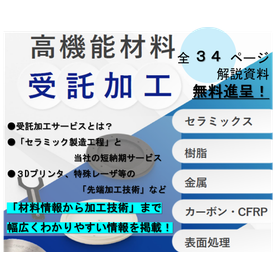Not thermal spraying? Ceramic coating for electronic component setters.
【New Technology】A new method different from thermal spraying ensures a solid film formation up to the setter end face! *Available in a range from standard grade to dense grade!
In electronic components, it can be said that there is almost always a "sintering" process. Therefore, we would like to introduce a ceramic coating method using a dipping technique that differs from conventional thermal spraying for the setters you are using. 【Four Features】 ◆ High freedom of shape, capable of coating 3D shapes at meter scale ◆ Coating possible on most high-performance materials ◆ Average thickness of 50μm achievable ◆ Coating surface has good roughness and excellent smoothness (Ra 0.8 or less) 【Materials that can be coated】 *Main setter materials ■ Mullite ■ Alumina-based ■ Zirconia-based ■ SiC-based *Both porous and dense materials can be accommodated. For coatings related to setters, many customers are selecting "zirconia films," so if you are having trouble choosing a film type, please try zirconia films first! Additionally, we currently have a lineup of dense grades of zirconia films, and by downloading, you can view SEM image data categorized by grade. In addition to zirconia, many other combinations of film types are possible, so please feel free to contact us.
basic information
(We have listed frequently asked questions) Q: Regarding the quantity of support A: We can accommodate from prototype to mass production. Q: I don't know how to select the type of film A: We will propose the optimal type of film based on the electronic components in question and the setter material. Q: What if I want to develop an original recipe? A: We can accommodate that. Q: Is it possible to request from the procurement of the base material? A: It is possible, but it may be cheaper if you provide the materials. ■ Please feel free to ask any other questions. (Method of film formation) 1. Generate the ceramic slurry you want to form a film with. 2. Dip the workpiece into the tank containing the slurry. 3. Dry and bake to cure. Since baking is required, the heat resistance temperature of the base material is also a key point. ■ Depending on the usage environment, baking may not be necessary. The unique dipping technology allows for high freedom of shape and adhesion, enabling discussions on various themes beyond thick films. ■ We also have sample products and various data available. We are always ready to accommodate meetings in person or via web meetings, so please feel free to reach out to us first.
Price range
Delivery Time
Applications/Examples of results
Narasaki Industries provides a one-stop service from material selection to completion and processed products. We are currently offering a comprehensive catalog of high-performance materials. For more details, please download the PDF and take a look.
catalog(5)
Download All Catalogs

Recommended products
Distributors
Narasaki Sangyo Co., Ltd. "Functional Materials Division" specializes in high-performance material contract processing. The materials we handle fall into "five categories": 1. Ceramics/Glass 2. Metals 3. Engineering Plastics 4. Carbon 5. Surface Treatment We offer a wide range of services, and if you provide us with a single production drawing, we can deliver various materials and surface treatments as a one-stop solution. We cater to everything from general-purpose to specialty materials, including high-precision, fine, electrical discharge, laser processing, as well as surface treatments such as coating, precision cleaning, and blasting. Our particular strength lies in high-precision and short-lead-time processing of ceramics. By machining from pre-fired materials, we achieve short lead times for ceramics that traditionally take several months. We handle a wide range of ceramics, including machinable ceramics like Hotovel, as well as fine ceramics such as alumina and zirconia, and non-oxide ceramics like silicon carbide, silicon nitride, and aluminum nitride. We are also actively engaged in proposing cost reductions for overseas ceramics and other international materials. We can accommodate various contract processing projects, from prototype development starting with a quantity of one to mass production.












